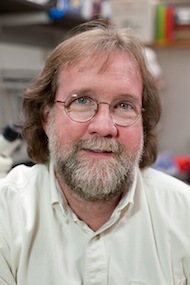“Your Inner Fish,” with strong UW connections, premieres on PBS

A University of Wisconsin–Madison professor wants to help more people get to know their ancestors.
Sean B. Carroll, Allan Wilson Professor of molecular biology, genetics and molecular genetics at UW–Madison and vice president of science education for the Howard Hughes Medical Institute (HHMI), is executive in charge of a new series on PBS exploring the early creatures from which humans evolved.
The series, “Your Inner Fish,” airs over three consecutive Wednesday nights beginning this week. In Madison, it will air at 9 p.m. It was created by Tangled Bank Studios, a production company founded by HHMI, though editorially separate from it.

Sean Carroll
“There are a lot of things in this series people have’t necessarily been exposed to,” Carroll says. “There is a lot of discovery there, in the context of essentially how our bodies have modified over the years from our fishy ancestors. It’s a story that’s never put been put together in any one place.”
Carroll is not the only UW–Madison connection to the series. John Hawks, associate professor of anthropology at UW–Madison, was an advisor on one of the production’s three hours. And UW–Madison graduate, Laura Helft, is senior researcher for Tangled Bank. She helped produce the new series.
“Your Inner Fish” is based on a book of the same name by writer and University of Chicago evolutionary biologist, Neil Shubin, who also hosts the television series. It explores the evolutionary ancestry of humans, looking at how fins became hands, gills became part of the inner ear and more.
“The book was a framework,” says Carroll. “It’s a really powerful but simple concept, that we’re modified fish. When you hear ‘Your Inner Fish’ you think: ‘What does that mean?'”
The series includes “anatomy, genetics, embryology and paleontology,” Carroll says. “It helps us understand our bodies and tells great stories of discovery, adventure and exploration.”
And, it will take viewers all over the world.
“There is a lot of discovery there, in the context of essentially how our bodies have modified over the years from our fishy ancestors. It’s a story that’s never put been put together in any one place.”
Sean Carroll
The series is part of HHMI’s commitment to advancing science education, Carroll says, and it’s only one part of the mission.
In addition to the broadcast series — meant for an audience that may have no prior knowledge related to the themes explored — HHMI has created a short film and other educational tools meant for teachers to use in the classroom.
“Our educational mission is being served by putting the broadcast specials on television while expanding materials in the classroom and providing that for free,” says Carroll.
The website contains free materials for teachers and students. Making films for use in the classroom is something Carroll has been doing through HHMI for the last three years, shortly after he assumed his current role.
“I saw the opportunity to do some things in science education on a national scale,” he said. “You can use mass media to tell great stories about great science and great scientists.”
But the success of these efforts, Carroll says, is truly measured by how far the ideas like “Your Inner Fish” reach into the classroom, how many kids across the country they reach and whether they make a lasting impact.
“To what degree will kids — future adults — look at their hands and say, ‘These are modified fish hands’,” he says. “‘Why do I get hiccups? Why do my friends get aching backs?'”
“That’s what I’m focused on.”
Tags: research


